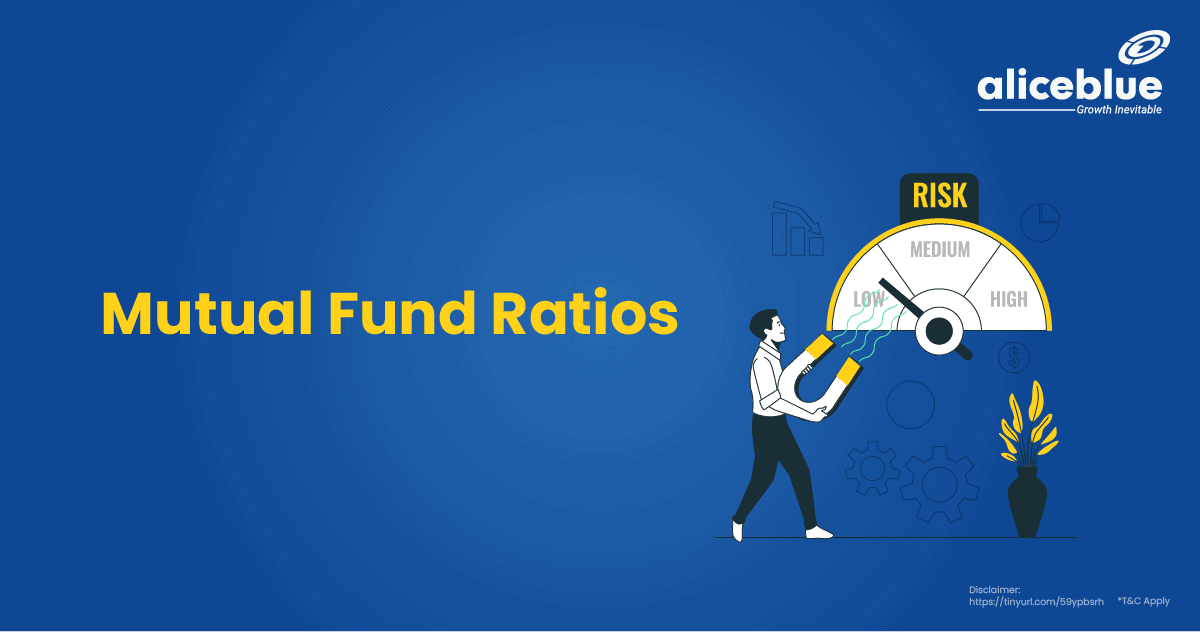Mutual Fund Ratios are analytical metrics that assess a fund’s performance, risk, and cost efficiency. Key ratios include expense ratio, Sharpe ratio, and alpha, which evaluate cost structure, risk-adjusted returns, and performance relative to a benchmark, respectively, aiding in informed investment decisions.
Content:
- What Is a Mutual Fund In India?
- What Is Mutual Fund Ratios?
- Mutual Fund Ratios
- Importance of Mutual Fund Ratios
- How do I check my MF performance?
- Mutual Fund Ratios – Quick Summary
- Mutual Fund Ratios – FAQs
What Is a Mutual Fund In India?
In India, a mutual fund is a financial instrument pooling money from various investors to invest in securities like stocks, bonds, and other assets. Managed by professional fund managers, it offers diversification and accessibility to individual investors seeking to grow their wealth.
Mutual funds in India are regulated by the Securities and Exchange Board of India (SEBI), ensuring transparency and investor protection. They cater to a range of investment objectives, from aggressive growth to stable income, making them suitable for a diverse investor base.
Investors in Indian mutual funds can choose from various fund types, including equity, debt, and hybrid, each with different risk-return profiles. These funds offer benefits like systematic investment plans (SIPs) and tax-saving options, appealing to both novice and experienced investors.
For example: If you invest Rs 10,000 in a mutual fund, your money is pooled with other investors’ funds. Suppose the fund grows by 10% in a year; your investment would then be worth Rs 11,000.

What Is Mutual Fund Ratios?
Mutual Fund Ratios are key metrics that investors use to evaluate and compare the performance, risk, and cost efficiency of mutual funds. These ratios include the expense ratio, Sharpe ratio, alpha, beta, and others, providing insights into a fund’s management effectiveness and investment profile.
The Expense Ratio measures the cost of managing a fund, expressed as a percentage of the fund’s total assets. It’s crucial to understand the impact of fees on returns. A lower expense ratio is generally preferred as it implies less cost to investors.
Risk and return ratios like Sharpe, Alpha, and Beta offer deeper insights. The Sharpe ratio indicates risk-adjusted returns, Alpha shows performance relative to a benchmark, and Beta measures market volatility sensitivity. These ratios help investors make informed decisions matching their risk appetite and investment goals.
Mutual Fund Ratios
Mutual Fund Ratios are essential metrics that evaluate a fund’s performance, risk, and cost efficiency. Key examples include the expense ratio, Sharpe ratio, and alpha, which measure management costs, risk-adjusted returns, and performance relative to benchmarks, aiding investors in making informed decisions.
- Expense Ratio
The Expense Ratio represents the annual cost of owning a mutual fund, including management fees, administrative costs, and other expenses. It’s expressed as a percentage of the fund’s assets. A lower ratio is preferable, as it means more of your investment goes towards growing your wealth rather than covering costs.
- Sharpe Ratio
The Sharpe Ratio assesses a fund’s risk-adjusted returns, comparing its performance to a risk-free asset, like government bonds. It helps determine how much extra return you’re getting for the extra risk taken. A higher Sharpe Ratio indicates better compensation for the risk incurred.
- Alpha
Alpha is a measure of a fund’s ability to beat its benchmark index. It shows the excess return of a fund compared to its expected performance, based on its risk level. A positive alpha indicates the fund manager’s skill in generating superior returns above the market average.
- Beta
Beta measures a fund’s volatility relative to the market. A beta greater than 1 implies more volatility (and potentially higher returns) than the market, while a beta less than 1 suggests lower volatility. It’s crucial to understand how a fund behaves in different market conditions.
- R-Squared
R-squared quantifies how much of a fund’s performance can be explained by movements in its benchmark index. Values range from 0 to 100; a higher R-squared means the fund closely tracks its benchmark, useful for evaluating how closely a fund follows its market index.
- Standard Deviation
Standard Deviation measures the variation in a fund’s returns over time, offering a snapshot of its volatility. A higher standard deviation indicates more fluctuation in returns and higher risk. It’s crucial to assess whether the potential return of a fund is worth the inherent risk.
Importance of Mutual Fund Ratios
The main Importance of Mutual Fund Ratios is that they provide investors with critical insights into a fund’s performance, cost efficiency, and risk level. These ratios help in comparing different funds, aligning investment choices with personal goals, and making informed financial decisions.
- Deciphering Costs: Expense Ratio
Understanding the Expense Ratio is crucial as it directly impacts returns. This ratio reveals the cost of fund management and operations, allowing investors to prefer funds with lower ratios for long-term savings on investment costs.
- Balancing Risk & Reward: Sharpe Ratio
The Sharpe Ratio is vital for evaluating the risk-reward balance. It shows how well a fund compensates for the risk taken. A higher Sharpe Ratio indicates more efficient performance relative to the risk, aiding in selecting funds that optimize returns for given volatility levels.
- Beating the Benchmark: Alpha
Alpha is key to assessing a fund manager’s expertise. It measures a fund’s ability to outperform its benchmark, reflecting the value added by the fund manager. Positive alpha signals superior management skills, guiding investors towards more skillfully managed funds.
- Understanding Volatility: Beta
Beta helps investors understand a fund’s volatility in relation to the market. It indicates how much a fund’s value might fluctuate, which is essential for matching investment choices with personal risk tolerance.
- Following the Leader: R-Squared
R-squared is significant for measuring how closely a fund’s performance mirrors its benchmark. A high R-squared means the fund closely tracks its index, important for those seeking performance similar to specific market segments.
- Assessing Fluctuation: Standard Deviation
Standard Deviation provides insights into a fund’s volatility, crucial for risk assessment. A higher standard deviation implies greater potential for return fluctuation, which helps investors choose funds aligned with their risk appetite and investment horizon.
How do I check my Mutual Fund performance?
To check your mutual fund (MF) performance, review its historical returns, compare them with benchmark indices, and assess the fund’s consistency over various market cycles. Analyzing mutual fund ratios like alpha, beta, and Sharpe ratios also offers insights into performance, risk, and management effectiveness.
Firstly, look at the fund’s annualized returns over different time frames, such as 1-year, 3-year, and 5-year periods. This comparison provides a perspective on how the fund has performed in the short and long term. Additionally, comparing these returns against relevant benchmarks (like Nifty or Sensex for Indian equity funds) helps in understanding the fund’s relative performance.
Secondly, consider qualitative factors like the fund manager’s experience and investment strategy. Changes in fund management or strategy can significantly impact performance. It’s also important to review the expense ratio, as higher expenses can eat into your returns. Regular monitoring and comparison with other similar funds can guide in making informed investment decisions.
Mutual Fund Ratios – Quick Summary
- In India, a mutual fund pools money from investors to invest in various securities, offering diversification and professional management, making it accessible for individuals aiming to grow their wealth.
- Mutual Fund Ratios, including expense ratio, Sharpe ratio, alpha, and beta, are crucial for assessing a fund’s performance, risk, and cost efficiency, offering valuable insights into its management effectiveness and investment profile.
- Mutual Fund Ratios, crucial for assessing a fund’s performance, risk, and cost, include the expense ratio, Sharpe ratio, and alpha. These metrics evaluate management costs, risk-adjusted returns, and benchmark-relative performance, guiding investors’ decisions.
- The main significance of Mutual Fund Ratios lies in offering key insights into a fund’s performance, cost, and risk, aiding in comparing funds, aligning with personal goals, and making informed financial choices.
- To evaluate mutual fund performance, examine historical returns, compare with benchmarks, assess consistency across market cycles, and analyze key ratios like alpha, beta, and Sharpe ratio for a comprehensive view of performance, risk, and management quality.
- Open free demat account with Alice Blue in 15 minutes today! Invest in Stocks, Mutual Funds, Bonds & IPOs for Free. Also, trade at just ₹ 15/order and save 33.33% brokerage on every order.

Mutual Fund Ratios – FAQs
1. What Is Mutual Fund Ratios?
Mutual Fund Ratios are key metrics that assess a mutual fund’s performance, risk, and cost efficiency, including expense ratio, Sharpe ratio, and alpha, providing investors valuable insights for comparing and selecting funds.
2. What Is Alpha Ratio In Mutual Fund?
In mutual funds, the Alpha Ratio indicates a fund’s performance relative to its benchmark index. It measures the fund manager’s ability to generate excess returns over the expected outcome based on market risk.
3. What is the Sorento ratio?
The Sortino Ratio is a variation of the Sharpe Ratio, used in finance to evaluate the risk-adjusted return of an investment portfolio, focusing specifically on the downside or negative asset price volatility.
4. What are the ratios used in mutual funds?
Mutual funds commonly use ratios like Expense Ratio, Sharpe Ratio, Alpha, Beta, Standard Deviation, and R-squared to evaluate performance, risk, and cost efficiency, aiding investors in comparing and selecting suitable funds.
5. How do you Analyse mutual fund ratios?
- Analyze mutual fund ratios by comparing them against industry benchmarks or similar funds.
- Consider long-term trends.
- Evaluate in the context of investment goals and market conditions.
- Make informed investment decisions.
6. How is the Sortino ratio calculated?
The Sortino Ratio is calculated by subtracting the risk-free rate from the fund’s return and dividing it by the downside deviation, focusing on negative volatility to assess risk-adjusted performance more precisely.
7. What Is A Good Alpha Ratio?
A good Alpha Ratio in mutual funds is typically a positive value, indicating the fund has outperformed its benchmark index. An Alpha above zero suggests above-average management performance, relative to the market risk taken.
To gain a better understanding of the topic and access more information , explore the articles below that cover mutual funds, stock market insights, trading strategies, and organizational perspectives.






